"Are we moving yet?” Perched on the balcony of our stateroom on Cunard’s Queen Elizabeth, a 2,000-person cruise ship currently docked at the Port of Vancouver, B.C., my sister Vivian and I ask each other this question several times as we’re set to sail away. There’s a mini bottle of champagne and two pre-chilled flutes on a small table between us, ready to commemorate the moment of departure.
It’s my first time on a cruise — a form of travel that I’ve actively avoided for the first three decades of my life. My sister went on a Caribbean cruise 15 years ago for my mother’s 60th birthday (I managed to excuse myself from this trip since I was living in Hong Kong at the time). From the balcony taking in the fresh air, Vivian already says this one’s an improvement.
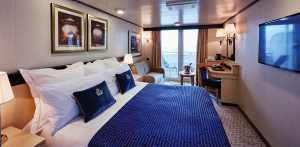
Inside one of the staterooms
I’ll admit to feeling a bit nervous about embarking on this trip. Yes, a jaw-dropping destination like Alaska and quality time away with my sister (now a mom to two kids) made this an easy trip to say yes to. But I also wondered: Would I get seasick? Or, sick of being at sea?
Suddenly, a sustained horn blows and we watch the port building opposing us move sideways. My sister pops the cork, dispensing the champagne between us. The effervescence swirls alongside the feelings of uncertainty in my stomach as I think about how the next nine days will pan out.
Wanting to get our sea legs under us, my sister and I venture out of our stateroom to get acquainted with the Queen Elizabeth, a 294-metre-long (about 10 TTC streetcar-lengths) ship with 12 decks that rise to the height of a 17-storey building.
Despite being built in 2010, the ship has a more classic Art Deco-style interior with curved arches, chandeliers and marble flooring. “Was your last cruise ship like this?” I ask Vivian. “No, it feels like we’re on the Titanic,” she jokes.
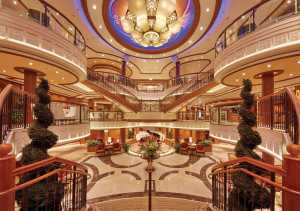
Though it was built in 2010, the ship is full of Art Deco-style fixtures
As we journey further from our departure point, the boat, at times, gains a discernible sway — more so when we’re out in open water. But it’s never enough to knock me off balance or to make me reach for the Gravol that my sister packed just in case.
We head one level above our stateroom to explore the decks above us. There are two outdoor pools, each with two small hot tubs and plenty of sun loungers and cushioned wicker patio seating around it. Another deck above has a sports area with old-timey lawn games like croquet, bocce and paddle tennis. The existence of these activities calms me, slightly, as a salve of potential activities to pass my time at sea.
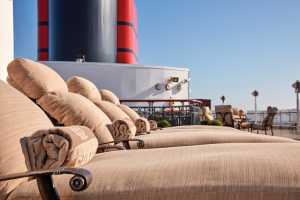
Guests can lounge outside on the terrace
It’s hard not to notice the obvious misplacement of my sister and I, both in our late 30s, among our fellow cruise passengers. We’re less than half the age of the average guest, many of whom are dependent on mobility devices like wheelchairs, electric scooters and walkers to get around.
This might have been more of a turn-off for me in my nightlife-seeking twenties, but now in my mid-thirties, I’m in bed by 10 p.m. some days. Perhaps I have more in common with my fellow guests than I realize.
But when it’s time for our first dinner, I go back to feeling out of place. Our meal at the Britannia Club is the most formal dining experience I can recall having in years. Picture polished silver salt and pepper shakers, and bread service complete with pre-piped rosettes of butter on a matching silver dish.
Then, rotating entrée options that, I might guess, our fellow guests would’ve dined on when they were my age: Coquille St. Jacques (scallops baked with cheese and mashed potatoes) and beef wellington. The dessert menu is practically pulled from The Great Canadian Baking Show’s technical challenges: Bakewell tarts, crêpes Suzette and a chocolate marquise.
Writer Andrea Yu and her sister Vivian spend nine days on Cunard’s Queen Elizabeth
Adding to the formality is a dinnertime dress code — collared shirts for men, and dresses or “formal separates” for women. Wearing shorts is discouraged past 6 p.m. On several evenings, there are black-tie galas, including one with a masquerade ball theme, and I learn that Cunard’s formality is part of its draw.
Firmly embedded in the post-COVID elasticized waistband life, we can use an excuse or three to get dressed up for dinner. Although, depending on our mood, my sister and I alternate our meals between the formal dining room and the buffet area, which is where I first become aware of the food waste issue that plagues most cruise ship dining environments (and any all-you-can-eat space in general).
A representative from Cunard later tells me that Carnival Corporation, the cruise industry behemoth that owns Cunard (along with Holland America and Princess Cruises) has recently introduced “biodigesters” (which break down and liquefy uneaten food) and dehydrators (they reduce volume by up to 90 per cent) on board to cut back on the volume of food waste their ships produce.
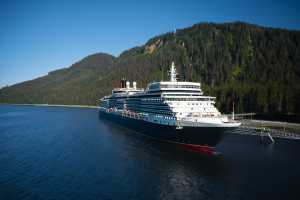
Cunard’s Queen Elizabeth travels from Vancouver to southern Alaska
Day two is our first full day at sea. And it doesn’t take long for my cabin fever to set in. Despite setting myself an agenda of activities to keep busy (a morning workout at the gym, midday manicures at the spa with my sister), by 4 p.m. I find myself feeling restless. After completing a few walking laps around the third deck — the Queen Elizabeth’s dedicated running track — Vivian suggests we find a quiet spot in the Commodore Club, a gentlemen’s club-like spot on the top deck with leather bar stools and upholstered armchairs. She’s eager to tuck into the first novel she’s attempted to read in a year. So I follow her lead, cracking open the Celeste Ng novel that I’ve borrowed from a friend for the trip. Within minutes, we both have fizzy beverages in one hand and books in the other as a live harpist plays covers of classic Hollywood movie soundtracks — an oddly soothing combination.
From black-tie galas to buffets, there’s plenty to eat on the ship
It seems the antidote to cabin fever isn’t to run dog-like zoomies around the space you’re confined to, but instead, to sit back, relax and enjoy the act of doing not very much at all.
Day three is another one at sea. It’s been touted as a “scenic cruising” day through Tracy Arm, an Alaskan fjord just south of Juneau. I’m not entirely sure what scenic cruising entails, but I soon find out. As we approach the fjord during our afternoon laps, we crane our necks sideways while power-walking to marvel at the forest-covered hills that come into view. Chairs, tables and loungers have been set out onto the ship’s open decks for patrons to take in the sights as we get closer to the fjord, so Vivian and I abandon our laps to find a prime viewing spot.
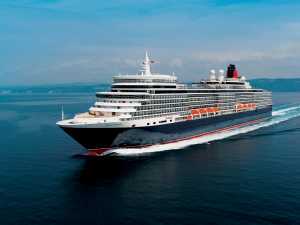
Cunard’s Queen Elizabeth is a luxurious vessel with Art Deco design touches
We get excited every time we pass by a hunk of ice floating in the sea (“Baby’s first iceberg!” I joke, as I snap a selfie). Our fellow guests are also armed with cameras and binoculars, flanked by excited octogenarians taking group photos with their tablets. Shutter clicks aside, I can sense the decibel level on the ship slipping down a few notches, the scenery rendering us into a collective speechlessness as we admire the epic views around us.
After an hour of scenic cruising, Vivian and I retreat to our stateroom to freshen up for a champagne afternoon tea. While my sister gets ready, I pop out onto our balcony to continue the restorative experience of what I’d like to call “fjord-bathing” — something of a second cousin to forest bathing.
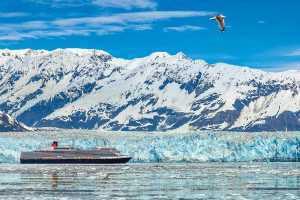
Cunard’s Queen Elizabeth cruises through an Alaskan fjord
I’m stopped in my tracks as soon as I step out on the balcony, spotting a massive glacier in the distance. Under its white craggy tops, a light blue hue emerges that deepens where the glacier meets the sea. My jaw drops, dumbfounded by the sheer size of the glacier and its rugged appearance, worthy of the many vodka bottles and water brands I’ve seen it on.
“Vivian, you should come out here,” I yell, not explaining why so that she can have the same shock as I did. The look on her face, as she lays her eyes on the glacier, lets me know she’s feeling the same sense of awe and wonder.
Champagne afternoon tea is served at Café Carinthia on the Cunard Queen Elizabeth
We spend about 15 minutes admiring the glacier from our balcony before the ship does a 180-degree turn to offer guests on the other side of the boat a view. Then, we retreat out of the fjord. By this time, Vivian and I are seated by a window in the Café Carinthia with three tiers of finger sandwiches and dessert squares between us, plus more flutes of champagne. Scenic cruising, it turns out, is pretty fun, especially when accompanied by alcohol and snacks.
Before I embarked on this voyage, I was looking forward to our three Alaskan port days in Sitka, Juneau and Ketchikan. We’ve booked excursions at each (sea kayaking, a forest hike and a boat journey to learn about crab trapping), but I’ll admit that they feel like canned experiences: We’re seeing three to five ships, some up to double our size, docked at each port we visit.
Excursions on port days allow guests to explore Alaska’s glaciers
Before and after each excursion, we have some free time to explore, but my anxiety about returning to the ship before the strict sail-away time keeps me from taking a deeper dive into each town, which I would have liked to do. I’ll probably still gravitate towards more independent and adventurous travel experiences in the future, but I can see the advantages of cruise vacations when the structure and predictability are a bonus — like if Vivian were to go on vacation with her two kids or if I was travelling with my somewhat anxious mother.
Our journey concludes with one full day at sea as we return to Vancouver. It passes much like our earlier days at sea — a morning workout, laps outside, a quiet spot to finish our novels (Vivian completes hers in the morning, which she proclaims triumphantly, and I finish mine by the afternoon). With a few hours to kill before dinner, instead of feeling anxious about how to pass the time, I find myself surprisingly looking forward to these final moments at sea with no agenda in particular.
